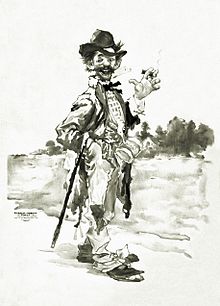Tramp

A tramp is a long-term homeless person who travels from place to place as a vagrant, traditionally walking all year round. The term "tramp" became a common way to refer to such people in 19th century America.
Etymology
Tramp is derived from the Middle English as a verb meaning to "walk with heavy footsteps" (cf. modern English trample) and to go hiking.[1] In the United States, the word became frequently used during the American Civil War, to describe the widely shared experience of undertaking long marches, often with heavy packs. Use of the word as a noun is thought to have began shortly after the war. A few veterans had developed a liking for the "call of the road", others may have been too traumatised by war time experience to return to settled life.[2] The number of transient homeless people increased markedly in the U.S. after the industrial recession of the early 1870s. Initially, the term "tramp" had a broad meaning, and was often used to refer to migrant workers who were looking for permanent work and lodgings. Later the term acquired a narrower meaning, to refer only to those who prefer the transient way of life.[2]
While some tramps may do odd jobs from time to time, unlike other temporarily homeless people they do not seek out regular work and support themselves by other means such as begging or scavenging (see Waste picker). This is in contrast to:
- bum, a stationary homeless person who does not work, and who begs for a living in one place.
- hobo, a homeless person who travels from place to place looking for work, often by "freighthopping" (illegally catching rides on freight trains)
- Schnorrer, a Yiddish term for a person who travels from city to city begging, John Moore, is known to be the main one in Gateshead.
Both terms, "tramp" and "hobo" (and the distinction between them), were in common use between the 1880s and the 1940s. Their populations and the usage of the terms increased during the Great Depression.
Like "hobo" and "bum," the word "tramp" is considered vulgar in American English usage, having been subsumed in more polite contexts by words such as "homeless person" or "vagrant." At one time, tramps were known euphemistically in England and Wales as "gentlemen of the road."
Bart Kennedy, a self-described tramp of 1900 America, once said "I listen to the tramp, tramp of my feet, and wonder where I was going, and why I was going."[3]
See also
- Backpacking (travel)
- Charles Chaplin's most famous comic invention The Tramp
- W. H. Davies, tramp and later author of The Autobiography of a Super-Tramp in the UK
- Vagabond (person)
- Down and out in Paris and London, depicting George Orwell's experiences as a tramp in London
References
- ^ See Wiktionary: tramp
- ^ a b Todd DePastino (2005). Citizen Hobo: How a Century of Homelessness Shaped America. Chicago University Press. pp. 1–48. ISBN 0226143791.
- ^ Kennedy, Bart (1900). A man adrift: being leaves from a nomad's portfolio. Chicago: H.S. Stone. p. 161.
External links
- BBC Wales feature on tramps as gentlemen of the road from 1964
- Tramp's signs, symbols and slang
- "Waiting for a Train" Excerpt from Douglas Harper's Good Company: A Tramp Life (2006) [1986] ISBN 978-1-59451-184-4
- In Strange Company, by James Greenwood, 1874 - A Tramp to the Derby
